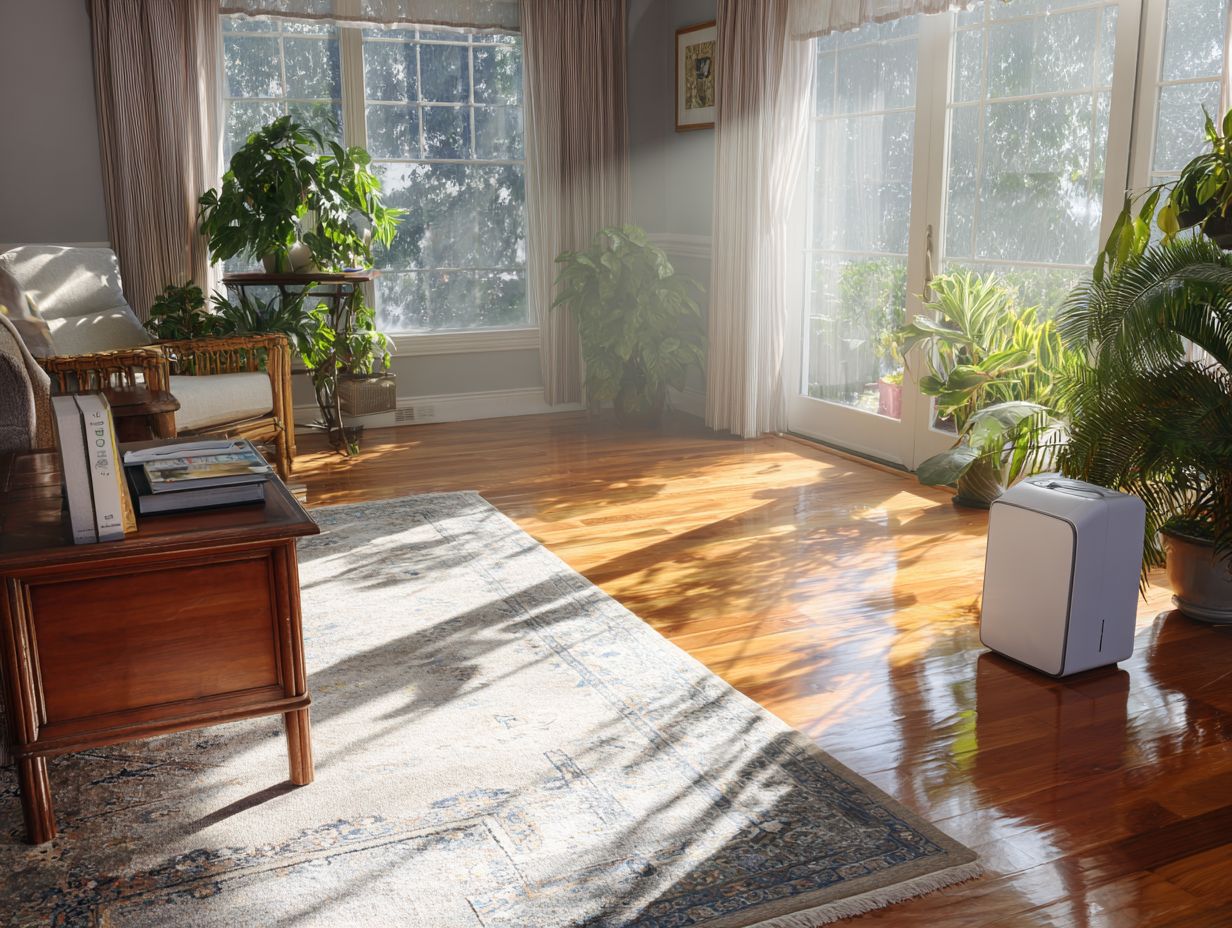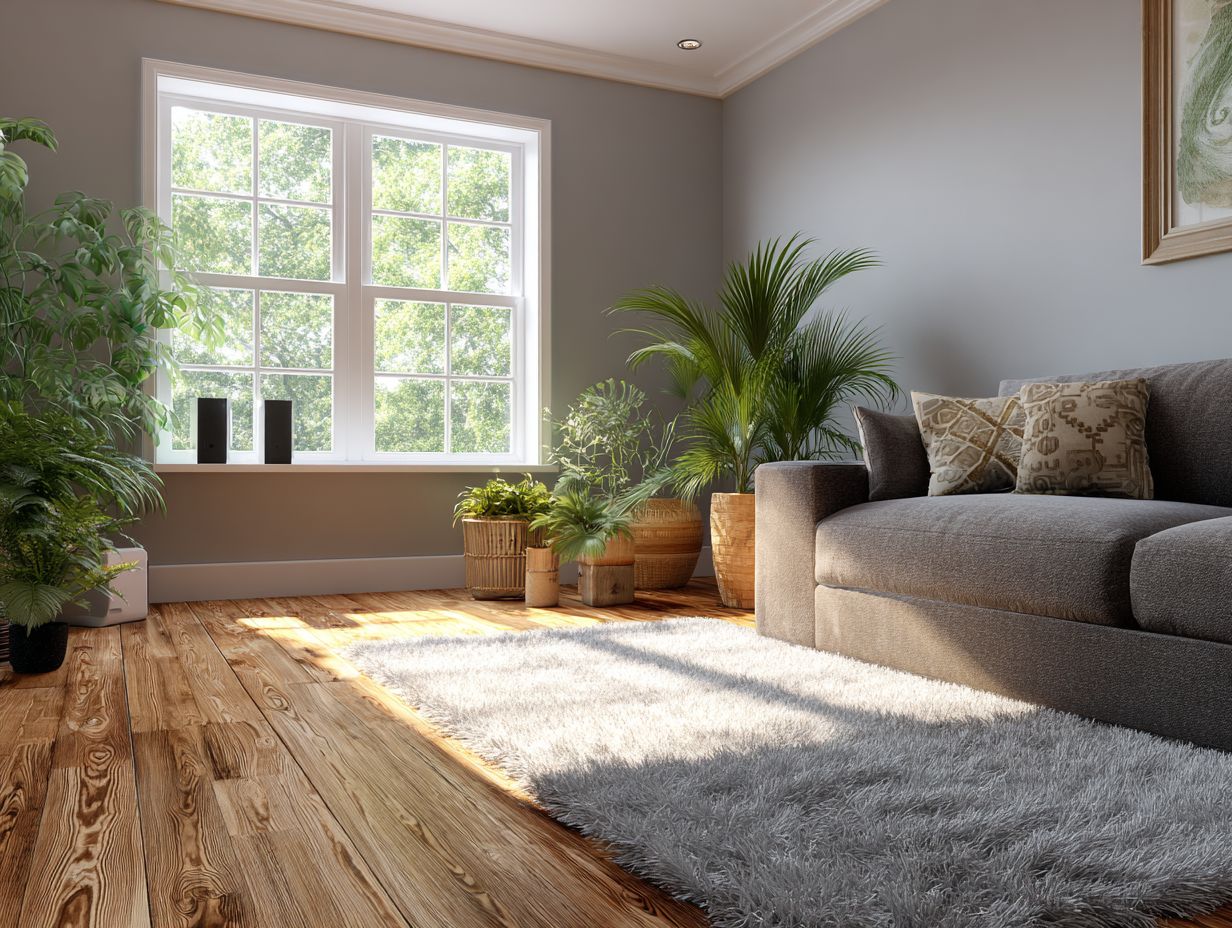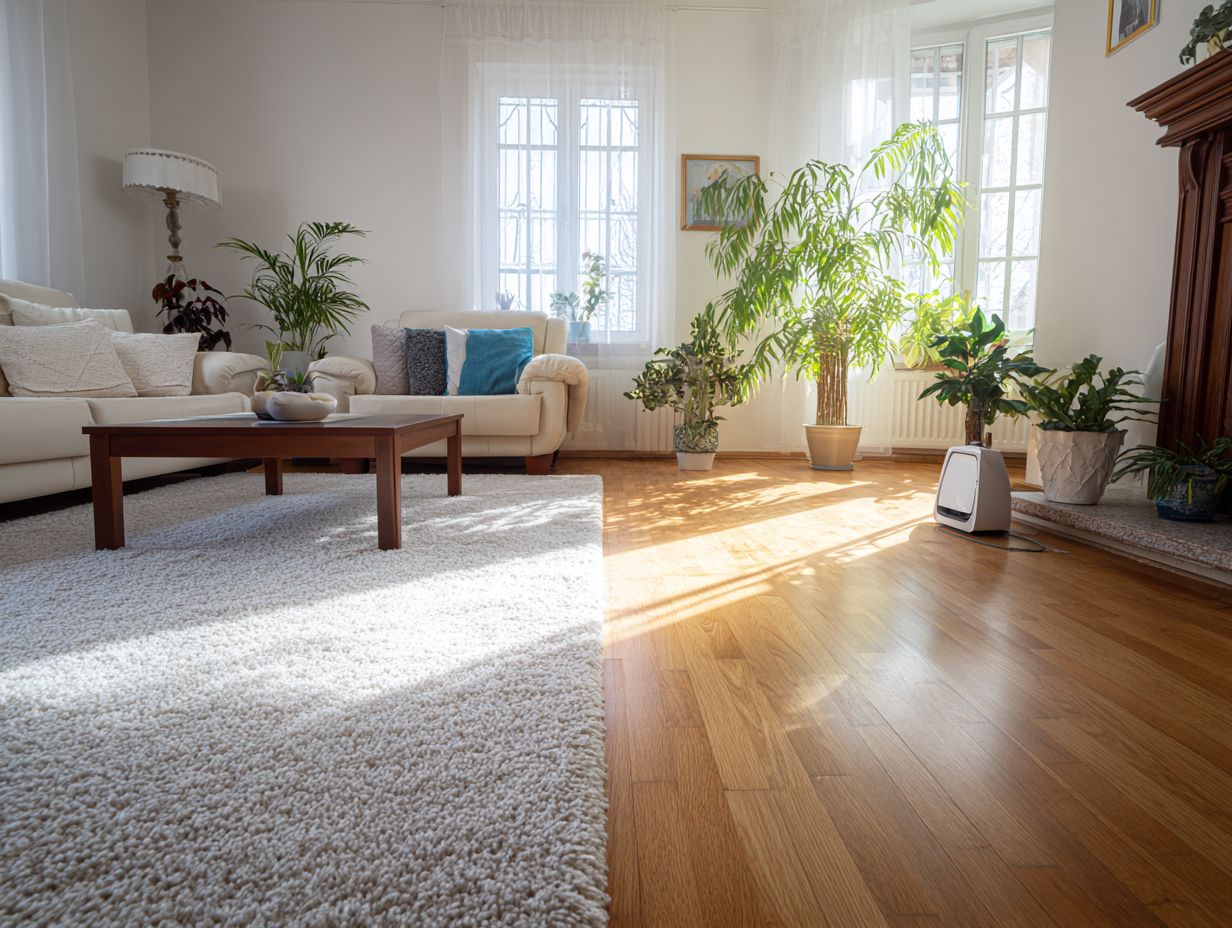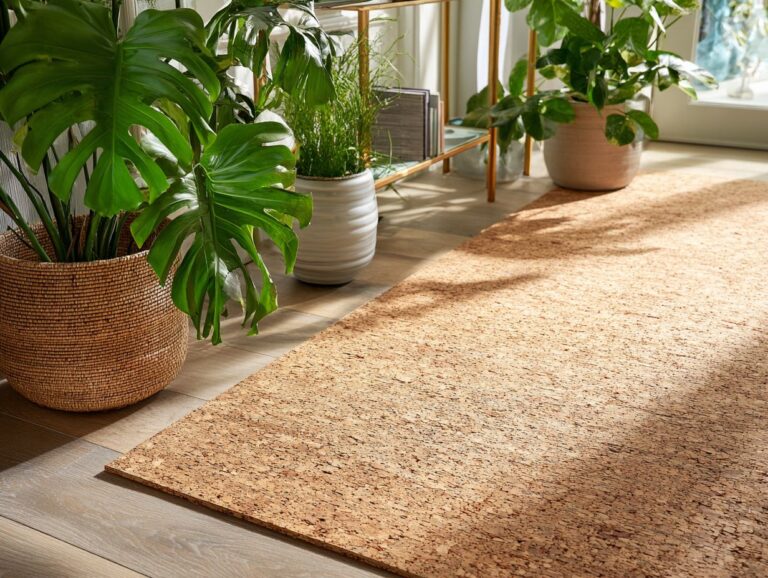Flooring and Indoor Air Quality – What to Know
Contents
- Introduction to Flooring and Indoor Air Quality
- Flooring and Indoor Air Quality Impact Statistics
- Types of Flooring Materials
- Volatile Organic Compounds (VOCs)
- Flooring Installation and Air Quality
- Maintenance and Cleaning
- Improving Indoor Air Quality
- Air Purifiers and Ventilation
- Regular Maintenance and Inspections
- Making Informed Flooring Choices
- **Upcoming Changes in Flooring and Air Quality** Soon, we will see changes in flooring materials and their impact on indoor air quality. Manufacturers are creating flooring options that not only look good but also help keep indoor spaces healthier. This involves reducing harmful chemicals and using more eco-friendly materials that lower pollutant emissions. The goal is to make air quality indoors better and support healthier living spaces. For more information, check out [this guide on sustainable flooring](#) and [this article on improving indoor air quality](#).
- Resources for Further Reading
- Frequently Asked Questions
- What types of flooring are best for indoor air quality?
- Can flooring materials emit toxic chemicals?
- How often should I replace my flooring for better indoor air quality?
- Can flooring affect the air quality in my home?
- Are there specific types of flooring that are better for those with allergies or respiratory issues?
- Can mold growth under flooring affect indoor air quality?
Introduction to Flooring and Indoor Air Quality

Key Takeaways:
Importance of Indoor Air Quality
Indoor air quality significantly influences health, with studies showing that poor IAQ can lead to respiratory symptoms in up to 50% of occupants in educational facilities.
Research highlights that common indoor pollutants, like mold, volatile organic compounds (VOCs), and dust mites, can exacerbate asthma symptoms.
For instance, a study published in the Journal of Asthma found that reducing humidity levels in classrooms led to a 30% decrease in asthma-related absenteeism.
To improve IAQ, consider using HEPA air purifiers, maintaining proper ventilation, and regularly cleaning HVAC systems.
Schools can also implement educational programs focused on reducing indoor allergens, thereby creating a healthier environment for students and staff.
Flooring and Indoor Air Quality Impact Statistics
Flooring and Indoor Air Quality Impact Statistics
Carpet Flooring and Health Impacts: Dust and Allergen Levels
Carpet Flooring and Health Impacts: Adverse Health Outcomes
The Flooring and Indoor Air Quality Impact Statistics offer a detailed examination of how carpet flooring impacts health, especially in relation to dust, allergens, and asthma risks. The data is important for making informed decisions about flooring choices in houses and workplaces.
Carpet Flooring and Health Impacts data highlights significant distinctions between carpeted and smooth floors. Carpets have a mite allergen concentration that is 10 times higher compared to smooth floors. This substantial difference suggests that carpets can harbor allergens more effectively, potentially exacerbating health issues for individuals sensitive to mites and other allergens.
- Dust and Allergen Levels: Carpets tend to resuspend dust at a 69.5% higher rate compared to hard surfaces. This increase in resuspended dust can worsen indoor air quality, leading to respiratory issues and discomfort for occupants, especially those with preexisting conditions like asthma.
Adverse Health Outcomes data detail the risks associated with carpeted environments. The odds ratio of 4.64 indicates a significantly higher risk of developing asthma in workplaces with carpeting. This information is important for bosses and facility managers who want to raise workplace health standards.
- In homes, the odds ratio of 4.07 The rise in asthma readmissions linked to bedroom carpets highlights the effect of carpeted floors on people with asthma. This statistic suggests a strong correlation between carpeted bedrooms and the frequency of asthma-related hospital visits.
- Children exposed to carpets early in life face a 1.4 times higher risk of developing asthma, highlighting the importance of considering flooring options in homes with young children. Reducing early exposure to carpet allergens could be a preventive measure to lower the incidence of childhood asthma.
The Flooring and Indoor Air Quality Impact Statistics emphasize the need for careful consideration of flooring materials. Carpets, while providing comfort and aesthetic appeal, can significantly affect indoor air quality and health. Knowing how these factors affect health can lead to smarter decisions at home and work, possibly lowering the occurrence and seriousness of breathing issues such as asthma.
How Flooring Choices Affect Air Quality
The choice of flooring materials directly impacts indoor air quality through the release of air pollutants such as VOCs and microbial contaminants from building surfaces.
For instance, laminate flooring often contains formaldehyde, a known VOC that can contribute to respiratory issues.
In contrast, solid wood or cork flooring can act as natural air purifiers since they have lower VOC emissions and can absorb some airborne pollutants.
Installing high-quality carpets with low volatile organic compound backing can further reduce indoor air pollution. Additionally, if interested, you might explore the health benefits of antimicrobial flooring options to enhance indoor air quality.
When choosing flooring, look for materials marked as low-VOC or approved by groups like GREENGUARD to promote a healthier indoor space.
Types of Flooring Materials
Different types of flooring materials can affect indoor air quality, with certain materials releasing more pollutants than others. To make environmentally conscious choices, learn more about eco-friendly flooring trends and explore sustainable options that minimize indoor pollutants.
Hardwood Flooring
Hardwood flooring is often favored for its aesthetic appeal and durability, but it can still emit VOCs depending on treatment and finishing processes.
Choosing hardwood flooring with low VOC emissions can significantly improve indoor air quality. Brands like Mika (known for its sustainable sourcing) and Bella Cera offer finishes that are both beautiful and emit fewer harmful chemicals.
Look for products labeled as ‘low-VOC’ or ‘no-VOC,’ made with water-based finishes. Looking after your floor matters; using safe cleaning products can help your floor stay in good condition and lessen environmental damage.
This method improves your home’s appearance and makes it a healthier place to live.
Laminates

While laminate flooring offers a budget-friendly alternative, it can release higher levels of formaldehyde and other VOCs, impacting indoor air quality.
To minimize these risks, opt for low-VOC laminate options which comply with stricter emission standards. Check for certifications like GREENGUARD or FloorScore, which guarantee healthier indoor spaces.
Choose reputable brands like Pergo, Shaw, or Mohawk, known for their commitment to sustainability. It’s also beneficial to let the laminate acclimate in a well-ventilated area before installation, as this can help reduce initial emissions.
After installation, regular ventilation and using air purifiers can improve indoor air quality even more.
Carpet
Carpet can collect allergens and pollutants, which may negatively affect indoor air quality if not cleaned regularly.
To make the air cleaner, it’s important to do regular maintenance.
- Vacuum carpets at least once a week using a vacuum with a HEPA filter to trap dust and allergens.
- Consider using low-VOC carpet options like nylon or natural wool, which emit fewer volatile organic compounds.
- Installing area rugs that you can easily wash can also help minimize dust accumulation.
Hiring professionals to clean your space every 12-18 months reduces harmful particles, improving the quality of your indoor air.
Vinyl and Linoleum
Vinyl and linoleum flooring are popular for their resilience but may release VOCs, especially when new.
When considering air quality, vinyl tends to emit higher levels of volatile organic compounds (VOCs) compared to linoleum, which uses natural materials like linseed oil.
To select products with low emissions, look for certifications such as FloorScore or GreenGuard Gold. These labels make sure we follow air quality rules.
Also, consider opting for thicker, high-quality options from reputable manufacturers, as they generally contain fewer harmful chemicals. Properly ventilating the area during installation can help reduce VOC levels, creating a healthier indoor environment.
Tile and Stone
Tile and stone flooring are among the best options for minimizing indoor air pollutants due to their inert nature and lack of VOC emissions.
These materials help clean the air, and putting them in correctly can make them work even better. For instance, using low-VOC grout and sealants prevents the leaching of harmful substances into the air.
Ensuring proper subfloor preparation promotes moisture control and reduces the risk of mold growth, which can contribute to indoor air pollution. Regularly cleaning these surfaces with a damp mop rather than harsh chemicals also helps maintain a healthier environment.
By combining quality materials with conscientious installation, you can significantly create a more breathable indoor space.
Volatile Organic Compounds (VOCs)
Volatile organic compounds (VOCs) are a big issue indoors because they can come from different things, like flooring materials. For those looking to minimize VOC exposure, exploring non-toxic flooring options can be a significant step towards maintaining a chemical-free home environment.
Sources of VOCs in Flooring
Common sources of VOCs in flooring include adhesives, finishes, and the materials themselves, with formaldehyde being a notable contributor.
To minimize exposure to VOCs, select low-emission flooring products like bamboo or cork, which naturally produce fewer volatile compounds.
Use adhesives with low VOC ratings, such as those certified by Greenguard. Correct installation methods are very important. Make sure there is enough ventilation during and after installation to let any leftover VOCs clear out.
Testing for air quality post-installation can also be beneficial, using simple kits available at hardware stores to verify a safe environment before moving in.
Health Effects of VOC Exposure
Exposure to VOCs can lead to significant health hazards, including respiratory symptoms and long-term chronic health issues.
VOCs, or volatile organic compounds, disproportionately affect vulnerable populations such as children and those with asthma.
For instance, children exposed to high levels of VOCs may experience increased risks of developing asthma, with studies indicating that up to 20% of asthma cases can be linked to indoor air pollutants. People with asthma experience worsened symptoms in places with high levels of volatile organic compounds (VOCs).
Effective measures include using air purifiers with activated carbon filters and maintaining proper ventilation to reduce indoor VOC concentrations. Regularly checking for sources, such as painting supplies or cleaning products, can also help mitigate exposure.
Flooring Installation and Air Quality
Putting in new floors can lower air quality for a short time because glues and coatings release chemicals into the air.
Off-Gassing During Installation

Off-gassing is a common phenomenon during flooring installation, particularly from adhesives and finishes that can release harmful chemicals into the air.
These volatile organic compounds (VOCs) can negatively impact indoor air quality, leading to headaches, respiratory issues, and long-term health concerns.
To mitigate off-gassing, consider using low-VOC or no-VOC products, such as water-based adhesives or natural finishes. Ventilate the space well during and after installation by opening windows and using fans to promote air circulation.
Allowing materials to off-gas in a well-ventilated area prior to installation can further reduce indoor chemical exposure.
Choosing Low-VOC Adhesives and Finishes
Choosing adhesives and finishes with low VOCs is important for keeping indoor air fresh during and after flooring installation.
Look for products with certifications like GreenGuard or FloorScore, which indicate low chemical emissions.
For instance, the Titebond III Wood Glue is a reliable option that meets low-VOC standards, while the Eco-Blend adhesive from Eco-Bond is both effective and environmentally friendly.
Using water-based finishes, such as Bona Traffic, can minimize harmful toxins. Check that your selected products show their VOC levels clearly on the label. Look for adhesives with less than 50 g/l and finishes with less than 100 g/l.
Maintenance and Cleaning
Indoor air quality is greatly impacted by maintenance and cleaning habits because many conventional cleaning products release harmful chemicals.
Impact of Cleaning Products on Air Quality
Common household cleaning products often contain VOCs, which can exacerbate indoor air pollution and impact health.
These VOCs, such as formaldehyde and benzene, can cause respiratory issues and allergies. To lower your risk, consider using natural products such as vinegar, baking soda, and castile soap.
For instance, a simple all-purpose cleaner can be made by mixing equal parts of vinegar and water, which effectively cuts grease and removes odors without releasing harmful chemicals. Brands like Seventh Generation and Method offer plant-based cleaners that are both effective and gentler on indoor air quality, providing a safer option for your home.
Best Practices for Maintaining Different Flooring Types
Different kinds of flooring need specific cleaning routines to keep air quality good over time.
-
For hardwood floors, regular sweeping and occasional damp mopping with a pH-neutral cleaner will help prevent dust buildup.
-
Tile floors benefit from weekly mopping using a gentle cleaner to reduce allergens trapped in grout.
-
Carpets should be vacuumed at least twice a week with a HEPA filter vacuum, and deep-cleaned quarterly with steam cleaning to eliminate dust mites.
-
For vinyl flooring, a simple weekly wipe-down with a microfiber cloth can keep surfaces clean and allergen-free.
Following these steps will create a healthier indoor environment.
Improving Indoor Air Quality
Improving indoor air quality involves using air purifiers and good ventilation systems (our guide to hypoallergenic flooring options can also help).
Air Purifiers and Ventilation
Using air purifiers with HEPA filters can significantly reduce pollutants in indoor environments, complementing proper ventilation systems.
HEPA filters capture 99.97% of particles down to 0.3 microns, effectively removing allergens like pollen, dust mites, and pet dander.
For optimal performance, consider models like the Coway AP-1512HH, known for its efficiency and quiet operation, or the Honeywell HPA300, which is ideal for larger spaces.
Place the air purifier in a spot away from walls and objects to keep the airflow as strong as possible.
Replace filters every 6-12 months and keep purifiers running constantly during high allergy times for the best results.
Regular Maintenance and Inspections
Regular maintenance and inspections are important to keep indoor air clean and spot problems early.
To maintain optimal indoor air quality, create a schedule for specific maintenance tasks.
- Use an indoor air quality monitor, such as the AirThings Wave or Foobot, to test for pollutants every three months.
- Look at the ventilation systems each month by examining the filters and ducts to assess their performance.
- Record your findings in a dedicated log; this documentation helps track air quality trends and identifies recurring problems.
Over time, this proactive approach supports healthier living environments and minimizes the risk of significant air quality issues.
Making Informed Flooring Choices

To make informed flooring choices, consumers must consider the health impacts associated with different materials and select those that promote a healthier indoor environment.
- Start by looking for certifications that indicate low emissions, such as FloorScore or GREENGUARD. These certifications confirm that flooring materials comply with stringent indoor air quality rules.
- Consider sustainable options like bamboo or cork, which naturally resist mold and allergens. When selecting vinyl, opt for phthalate-free products to reduce harmful chemical exposure.
- Learning about these certifications and what they mean can greatly improve indoor air quality, leading to a healthier home.
**Upcoming Changes in Flooring and Air Quality** Soon, we will see changes in flooring materials and their impact on indoor air quality. Manufacturers are creating flooring options that not only look good but also help keep indoor spaces healthier. This involves reducing harmful chemicals and using more eco-friendly materials that lower pollutant emissions. The goal is to make air quality indoors better and support healthier living spaces. For more information, check out [this guide on sustainable flooring](#) and [this article on improving indoor air quality](#).
Emerging trends in flooring innovation are focused on improving indoor air quality through the development of low-emission materials and sustainable practices.
One promising progress is the use of self-cleaning materials, which use nanotechnology to eliminate dirt and pollutants.
Another exciting development is the incorporation of air quality monitoring systems directly into flooring. For example, specialized tiles can monitor harmful chemicals in the air and notify homeowners when levels increase, enabling early action.
Manufacturers are exploring natural biocides within materials to further reduce microbial growth. These innovations improve how things look and make indoor spaces healthier.
Resources for Further Reading
For people interested in learning more about indoor air quality and flooring, many resources provide helpful information and research results.
Two noteworthy articles include:
- “Improving Indoor Air Quality in Schools” by the U.S. Environmental Protection Agency, which discusses ventilation and materials impact.
- “The Floor and Its Effects on Indoor Air Quality” published by the National Floor Safety Institute, covering flooring choices and their emissions.
For detailed research, the book “Indoor Air Quality Handbook” by B. Schwartz offers detailed analysis and practical solutions. These resources can greatly increase your knowledge and help you make better choices when picking flooring materials.
Frequently Asked Questions
What types of flooring are best for indoor air quality?
Hard surface flooring, such as hardwood, tile, or laminate, is typically better for indoor air quality compared to carpets. This is because carpets can trap dust, allergens, and other particles, which can affect air quality.
Can flooring materials emit toxic chemicals?
Some flooring materials, such as vinyl, laminate, and carpet, can emit volatile organic compounds (VOCs) which are known to be harmful to indoor air quality. It is important to research and choose low-VOC flooring materials to minimize potential health risks.
How often should I replace my flooring for better indoor air quality?
It is suggested to replace carpets every 5-7 years, as they can gather dust, allergens, and other particles over time. Hard surface flooring may only need to be replaced if it becomes damaged or worn out.
Can flooring affect the air quality in my home?
Yes, flooring can have a significant impact on indoor air quality. The type of flooring, its age, and maintenance can all affect the air quality in your home. To keep indoor air quality good, make sure to clean and care for your floors regularly.
Are there specific types of flooring that are better for those with allergies or respiratory issues?
Yes, hard surface flooring is generally recommended for those with allergies or respiratory issues, as it is easier to clean and does not trap allergens as much as carpets. Picking low-VOC flooring materials can help people who are sensitive to harsh chemicals.
Can mold growth under flooring affect indoor air quality?
Yes, moisture and humidity under flooring can lead to mold growth, which can affect indoor air quality. Quickly fix water damage or leaks and make sure areas with floors, like bathrooms, have good airflow to stop mold from growing.



